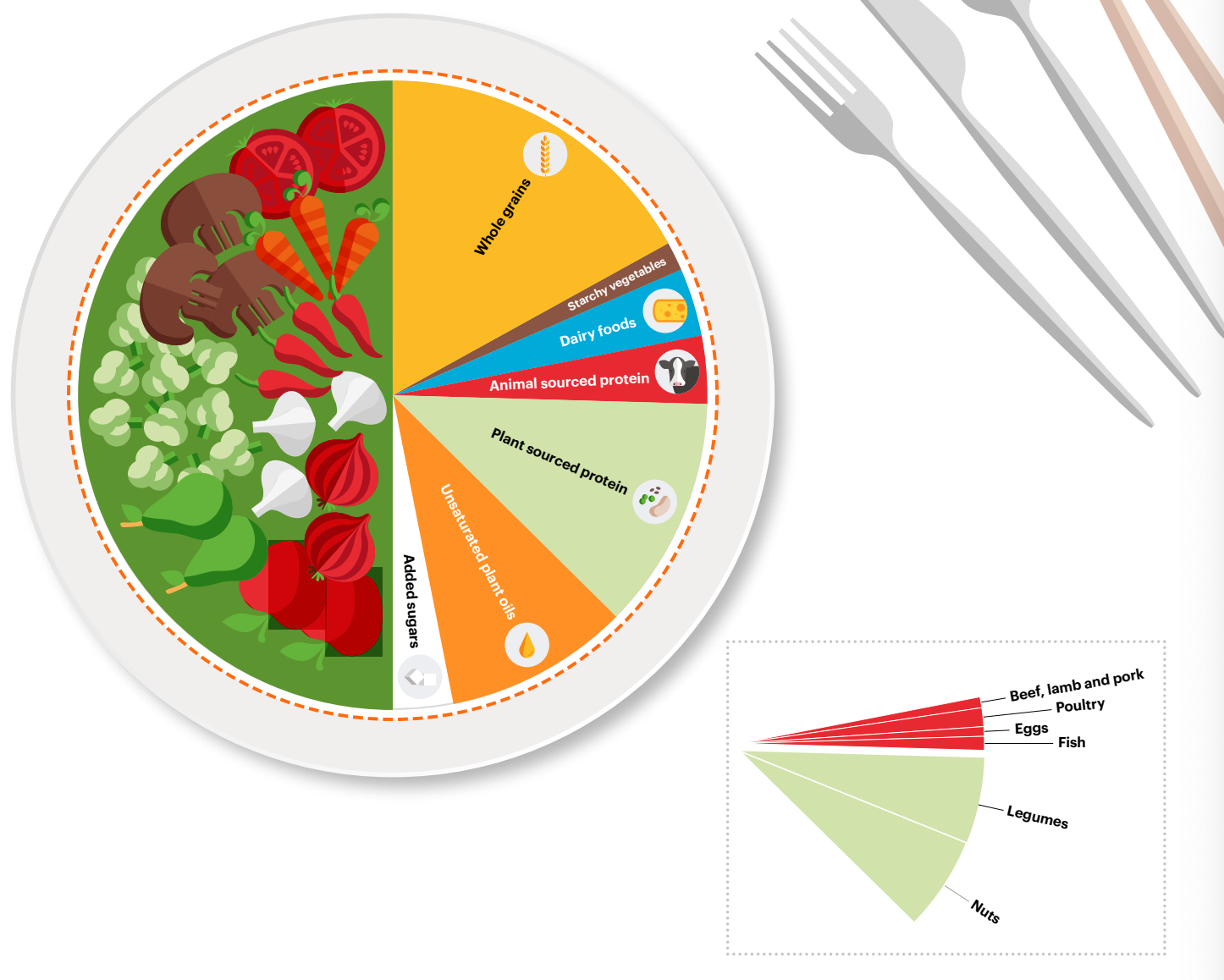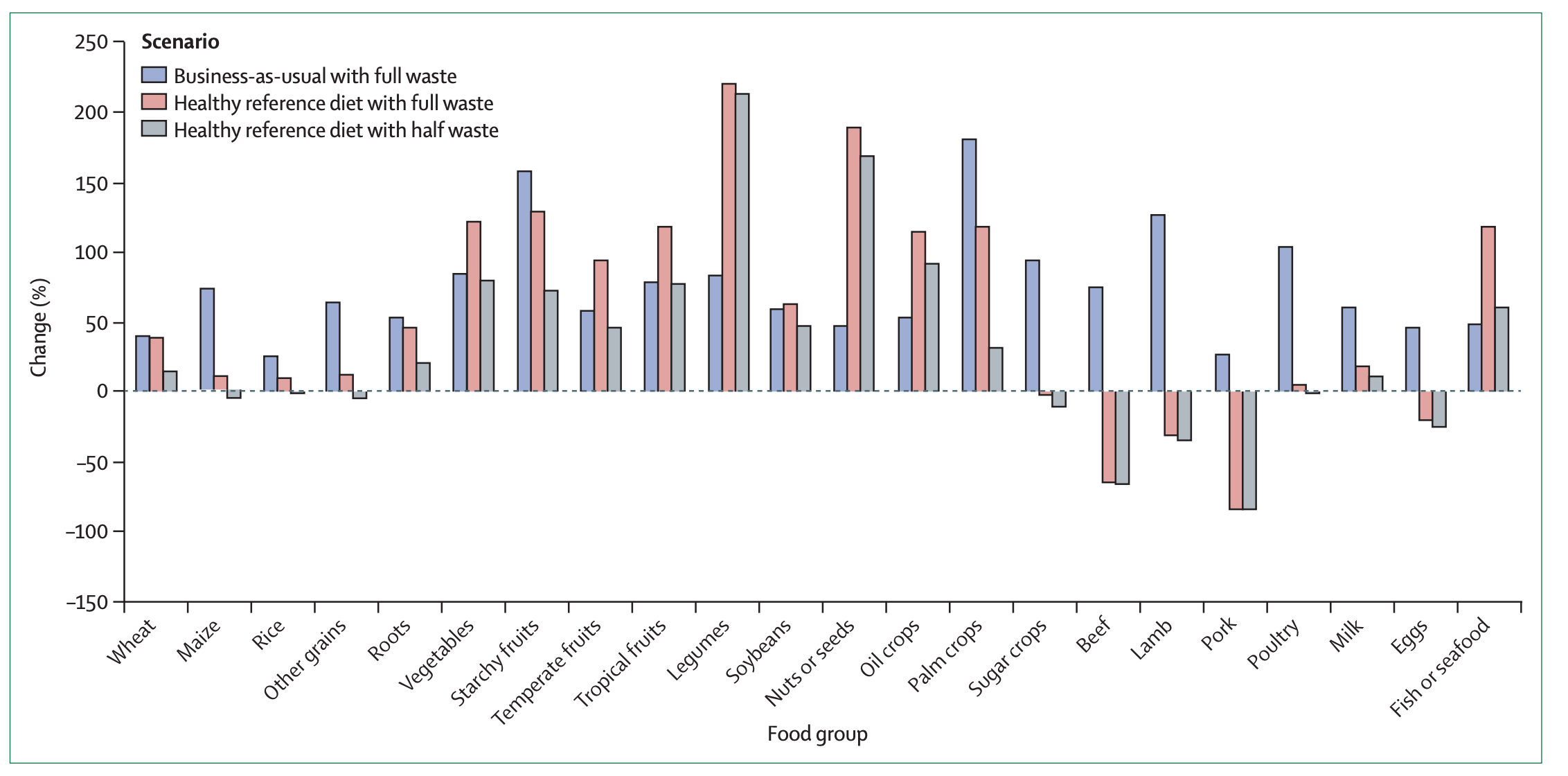Nela Motyckova
Major dietary shifts are needed in order to achieve the transformation to healthy diets by 2050. EAT Lancet considers both health and environmental boundaries when identifying the optimal diets as well as the necessary changes and strategies to achieve them. Global consumption of legumes, vegetables, fruits and nuts will need to be increased substantially. On the other hand, we will need to decrease the consumption of meat, other animal products and sugar crops by great amount. This plant-based diet with modest amount of animal protein sources constitutes the diet that is optimal from both human and planetary point of view.
The Global Challenge
The global population is growing, though only at decreasing pace due to lower levels of fertility. It is estimated that there are currently 7.7bn people worldwide (in 2019), and the medium-variant estimate by the United Nations suggests that the global population could grow to ca. 8.5bn in 2030, ca. 9.7bn in 2050, and could reach 10.9bn in 2100 (UN, 2019).
At the same time, malnutrition is the main cause of death in the world (WHO, 2019). As another extreme, the worldwide obesity has nearly tripled since 1975 and in 2016, more than 1.9bn adults were overweight (WHO, 2020). We consume excessive amounts of fats, red meat, processed food, and sugars (EAT Lancet, 2019). These unhealthy diets subsequently result in various cardiovascular diseases (such as stroke), diabetes, musculoskeletal disorders and some types of cancers (WHO, 2020).
Major shifts in our diets are thus needed in order to make the world population healthier and to prevent some of the diseases. At the same time, it is important to think about the environmental perspective when putting together the right proportions of different ingredients on the people’s plates worldwide (EAT Lancet, 2019). The agricultural production has a substantial impact on the environment, causing deforestation, water pollution, and greenhouse gas emissions, that comes mostly from the livestock production. It is estimated that the emissions from agriculture account for ca. 11% of global greenhouse gas emissions. Agriculture is as well a major source of land-use change (WRI, 2019).
Therefore, it is important to think about the changes that are necessary in order to feed the 10bn people worldwide by 2050 in a way that is as efficient as possible, meaning that there is no increasing environmental burden caused by the agricultural production. At the same time, it is important to think about diets that are healthy, possibly lowering the proportion of overweight and obese people and helping to fight malnutrition in the world (EAT Lancet, 2019).
EAT Lancet Commission: The Planetary Plate
EAT Lancet Commission on Food, Planet, Health is composed of 37 top global scientists from 16 countries and diverse disciplines answering the question: „Can we feed a future population of 10 billion people a healthy diet within planetary boundaries?“ Their answer is, that it is possible. If we change the way we produce, consume, transport and waste food, we can feed everyone a healthy diet while improving the health of our planet. The experts in the report identify a set of global scientific targets and integrate them into a framework of safe operating space for food systems – which constitutes of targets for both intakes of food as well as sustainable food production. The experts conclude that if no action takes place, we are at risk of failing to meet the United Nations Sustainable Development Goals and the Paris Agreement.
The healthy diet is designed to optimize humans‘ health, which is defined in a broad sense by the WHO – it is complete physical as well as mental and social health. Although it is difficult to set a specific diet that would satisfy the different needs of people of different age, health status, physical activity levels and other aspects, the researchers set a general guideline that should be applicable to healthy individuals aged 2 and older. In order to identify the optimal diet, they study evidence from controlled feeding studies, observational studies as well as randomized clinical trials. Further, they use the nutritional values of different food groups to define the ranges of intakes for each of the groups with high confidence.

Figure 17.1 – Planetary health plate as defined by the EAT Lancet Commission (EAT Lancet, 2019).
Finally, the result is that the optimal healthy plate should be composed of: one half of fruits and vegetables, 1/5 of whole grains, 1/6 of plant sources of protein (legumes and nuts), and the rest is composed of unsaturated plant oils, dairy foods, animal-sourced protein (beef, lamb and pork, poultry, eggs, fish), added sugars, and starchy vegetables (the proportion is in decreasing order). Taken all together, the optimal and healthy diet is largely plant-based, with low amount of animal products. The Commission argues, that this composition of a healthy diet allows high flexibility as it is compatible with a wide range of foods, agricultural systems of different countries, their customs, as well as individual preferences. They use the Mediterranean diet as an example of a healthy plant-based diet.
Shift to healthy diets and the benefits
Transformation to healthy diets by 2050 calls for major dietary changes. The reduction in the food waste is also one of the crucial aspects of the transformation. The Commission identifies different scenarios of the change in production from 2010 to 2050: business-as-usual with full waste; healthy reference diet with full waste; and lastly, the healthy reference diet with half waste.

Figure 17.2 – Predicted change in production from 2010 to 2050 for different scenarios (EAT Lancet, 2019).
In the above figure, it can be seen that we need to more than double the production of legumes, nuts and seeds. We need to as well substantially increase the production of the healthy foods such as vegetables, temperate and tropical fruits, oil crops, palm crops and fish (under the healthy reference diet with full waste). On the other hand, in the shift to the healthy diets, we need to decrease the production of pork and beef by large amounts. However, the EAT Lancet Comission highlights the importance of careful consideration of the specific contexts of the food production and consumption. For example, Sub-Saharan Africa depends largely on the consumption of starchy vegetables (potatoes), so a major shift is very difficult to implement.
Food systems have a scientifically proven impact on human health. The EAT Lancet quantitatively identifies the universal healthy reference diet as a basis for estimating the health and environmental effects of adopting this new diet as an alternative the current standard diets, which often consist of unhealthy foods. The Commission pairs this diet with country-specific food composition and shows that changing to the reference diet improves intakes of most nutrients – for example healthy fats and most micronutrients. The only exception is vitamin B12, which is low in plant-based diets, so supplementation is necessary.
In order to estimate the impact of the shift to the healthy diets, the Commission uses three approaches of the analysis on the diet-related disease mortality. All of these approaches conclude that the changes from the current state towards the healthy diets are likely to result in substantial health benefits, including a large decrease in the total mortality and reduction of non-communicable diseases. Specifically, approach 1 analyses the comparative risk and concludes, that 19% or 11.1 mil. adult deaths per year could be avoided as a result of the shift to the planetary health diet. Approach 2 analyses the global burden of disease: 22.4% or 10.8 million adult deaths per year could be avoided. Finally, approach 3 analyses the empirical disease risk: 23.6% or 11.6 million adult deaths per year could be avoided by the shift.
Special emphasis is given to the sources of protein, as many diets are defined according to this criterion (eg. vegetarian, vegan or pescatarian diet). The experts estimate that the ideal intake of protein for adults is ca. 0.8 g/kg per day and conclude that high-quality protein is important for the growth of children and elderly people, however, high intake might not be optimal for grown adults. Regarding the frequently-discussed vegetarian diet, they highlight the 2015 US Dietary Guidelines Advisory Committee that concludes that vegetarians, vegans, pescatarians, and semi-vegetarians have 12% lower overall mortality risk than the omnivors, with pescetarians achieving the lowest risk.
Strategy for implementation of healthy diets from sustainable food systems
The data provided by the report are strong enough to warrant prompt action. However, there is a need for inter-governmental, multi-sector and transdisciplinary action in order to achieve the given targets. The nations should aim at making healthy food more available, accessible, and affordable alternative to unhealthy foods to the citizens. Moreover, they should make individuals more informed about the necessary changes. Regarding agriculture, the countries should shift from the production of high quantity to the more intensified and effective production of high-quality and healthy food. There is as well a need for international agreements on the governance of the land and oceans, possibly avoiding the expansion of the agricultural land. One of the important strategies is to cut the food losses (at the production side) and food waste (at the consumption side) dramatically, in line with the UN Sustainable Development Goals. This all together would lead to an effective and rapid shift towards healthy diets from sustainable food systems (EAT Lancet, 2019).
Reference list:
WHO (2019). Malnutrition is a world health crisis. Available at: https://www.who.int/nutrition/topics/world-food-day-2019-malnutrition-world-health-crisis/en/ (Accessed on 23/3/2020).
EAT Lancet (2019). Food Planet Health – Healthy Diets From Sustainable Food Systems. Summary report. Available at: https://eatforum.org/content/uploads/2019/07/EAT-Lancet_Commission_Summary_Report.pdf (Accessed on 23/3/2020).
EAT Lancet (2019). Food in the Anthropocene: the EAT–Lancet Commission on healthy diets from sustainable food systems. Full report. Available at: https://www.thelancet.com/journals/lancet/article/PIIS0140-6736(18)31788-4/fulltext (Accessed on 23/3/2020).
WHO (2020). Obesity and overweight. Available at: https://www.who.int/news-room/fact-sheets/detail/obesity-and-overweight (Accessed on 23/3/2020).
UN (2019). World Population Prospects 2019. Highlights. Available at: https://population.un.org/wpp/Publications/Files/WPP2019_Highlights.pdf (Accessed on 23/3/2020).
WRI (2019). 5 Questions About Agricultural Emissions, Answered. Available at: https://www.wri.org/blog/2019/07/5-questions-about-agricultural-emissions-answered (Accessed on 23/3/2020).
Media Attributions
- Screenshot 2020-03-23 at 13.54.22
- Screenshot 2020-03-23 at 20.39.49